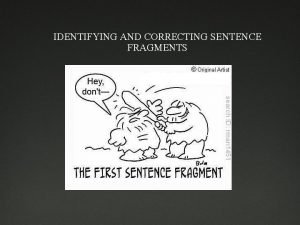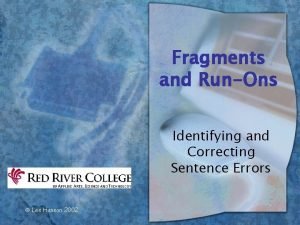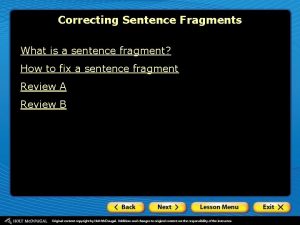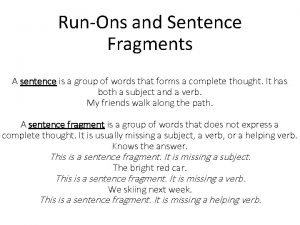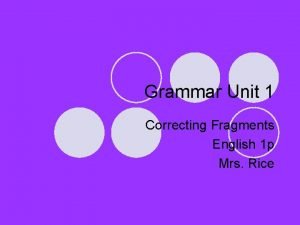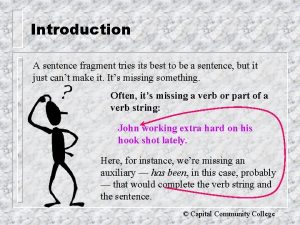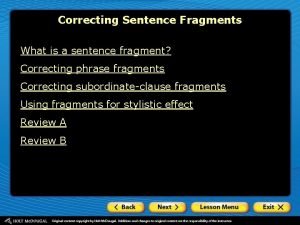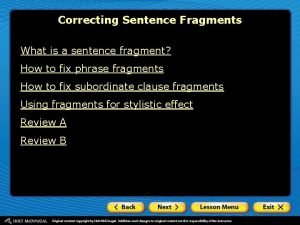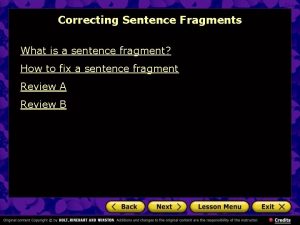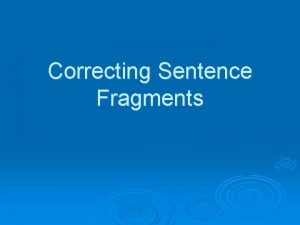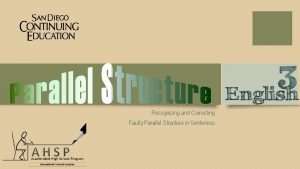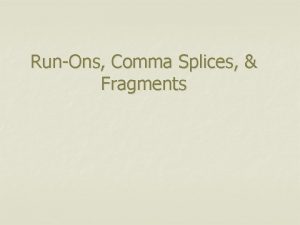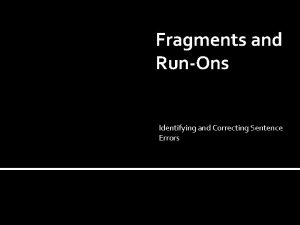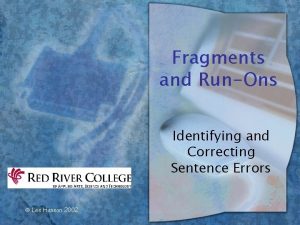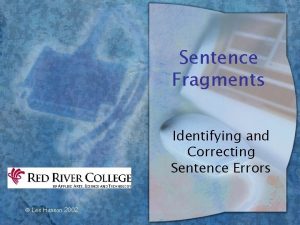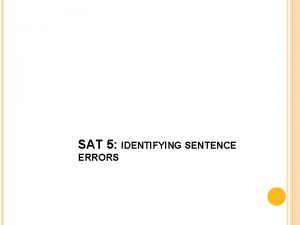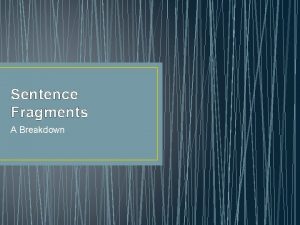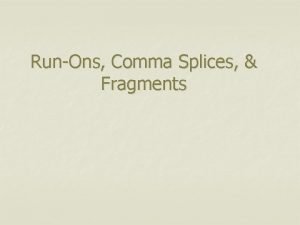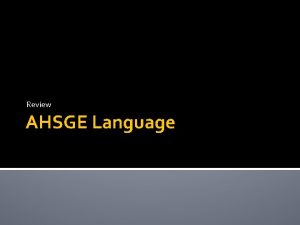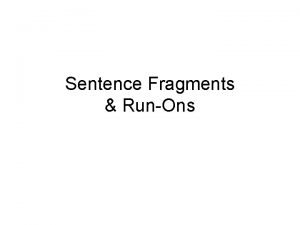Fragments and RunOns Identifying and Correcting Sentence Errors














- Slides: 14

Fragments and Run-Ons Identifying and Correcting Sentence Errors Les Hanson 2002

Introduction w This presentation explains the following grammatical concepts: Ø Clauses (dependent and independent) Ø Sentences Ø Fragments Ø Run-Ons Ø Semicolons and conjunctive adverbs

Clauses w A clause is a group of words with a subject and a verb Subject You Sally Verb stink. is talking. w Most clauses have further information after the verb I Subject Sally Verb hate grammar is talking loudly

Two Types of Clauses w Independent clause (Main clause) Can stand alone as a sentence Ø Can be joined to another clause Ø Ø Fred filled a cardboard tube with gunpowder. w Dependent clause (Subordinate clause) Cannot stand alone as a sentence Ø Must be joined to an independent clause Ø Because he wanted to make his own firecrackers. Ø A word that joins clauses is a conjunction

Joining Clauses w A dependent clause can be joined to an independent clause to make a sentence Ø Fred filled a cardboard tube with gunpowder because he wanted to make his own firecrackers. Or Ø Because he wanted to make his own firecrackers, Fred filled a cardboard tube with gunpowder. When the sentence starts with the dependent clause, it must have a comma before the independent clause

Fragments w Fragments look like sentences but are missing a subject or a verb, or they are put together incorrectly. Fragment Error Told everyone to get out of No subject the way. Disposable lighter in his No verb hand. Before he lit the fuse. A dependent clause by itself

Correcting Fragments w Subjects or verbs can be added w Fragments can be joined together w All of the following are correct With his disposable lighter in his hand, he told everyone to get out of the way. Then he lit the fuse. Ø Pulling out his disposable lighter, Fred told everyone to get out of the way before he lit the fuse. Ø He pulled out his disposable lighter. Fred told everyone to get out of the way and then he lit the fuse. Ø

Run-ons w Run-ons (fused sentences) occur when clauses are joined incorrectly. Comma splice Run-on He didn’t throw the firecracker, he placed it between his legs, he wanted to put the lighter away first. The fuse burned too quickly before he could throw it the explosive blew up between his legs.

Four Ways to Correct Run-ons 1. Join the clauses with a comma and a coordinating conjunction Ø Ø And, or, but, so, yet He wanted to put the lighter away first, so Fred placed the firecracker between his legs, and he didn’t throw it. 2. Join the clauses with a subordinating conjunction Ø Ø Because, although, if, when, since, after Because the fuse burned too quickly before he could throw it, the explosive blew up between his legs.

Four Ways to Correct Run-ons 3. Make the clauses into separate sentences Fred fell down screaming when the smoke cleared we all expected to see a bloody mess. ü Fred fell down screaming. The smoke cleared. We all expected to see a bloody mess. ü Fred fell down screaming. When the smoke cleared, we all expected to see a bloody mess. X

Four Ways to Correct Run-ons 4. Join two independent clauses with a semicolon (; )if they are closely related. Ø Ø You may include a conjunctive adverb along with the semicolon: however, for example, therefore, moreover, indeed, consequently X Fred hadn’t taped the tube properly and most of the ü force was released out the ends of the tube the explosion did direct some pressure against his groin. Fred hadn’t taped the tube well and most of the force was released out the ends of the tube; however, the explosion did direct some pressure against his groin. Notice how the sentence is punctuated

Correct the following 1. Fred managed to make it home and change his clothes, and he told his parents he fell off his bicycle, he avoided punishment for playing with explosives. ü Fred managed to make it home and change his clothes. He told his parents he fell off his bicycle, thus avoiding punishment for playing with explosives. ü Fred managed to make it home. He changed his clothes and told his parents that he fell off his bicycle. He avoided punishment for playing with explosives. 2. I left town shortly after. Didn’t see him again for five years. ü I left town shortly after and didn’t see him again for five years.

Correct the following 3. Took a trip home last summer. I ran into Fred after my long absence he is unable to have children. Didn’t ask if he still plays with firecrackers. ü During a trip home last summer, I ran into Fred after a long absence. He is unable to have children. I didn’t ask if he still plays with firecrackers. ü After a long absence, I took a trip home last summer. I ran into Fred, who is unable to have children. I didn’t ask if he still plays with firecrackers.

Interactive Exercise w You can get further practice by clicking the button below or by following the link to the interactive exercise Ø http: //xnet. rrc. mb. ca/leshanson/Hot_P otato/Sentence_Structure_6. htm
 Identifying complete sentences
Identifying complete sentences Identifying and correcting fragments
Identifying and correcting fragments Correcting fragments
Correcting fragments Run on fragment
Run on fragment Lesson 1 correcting sentence fragments
Lesson 1 correcting sentence fragments Identifying sentence fragments
Identifying sentence fragments Subordinate clause fragments
Subordinate clause fragments Fragment paragraph
Fragment paragraph Correcting fragments
Correcting fragments Correcting fragments
Correcting fragments Identifying sentence errors practice with answers
Identifying sentence errors practice with answers Recognizing parallel structure
Recognizing parallel structure Error in accounting
Error in accounting Runons
Runons Adjective
Adjective
